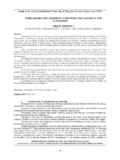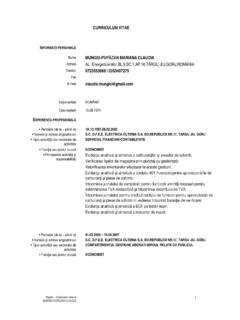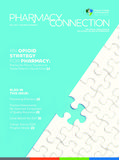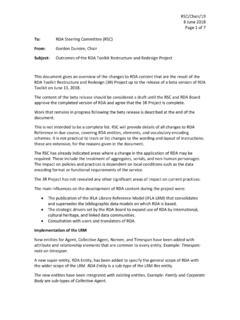Transcription of CELEBRITY ENDORSEMENT STRATEGY CHIOSA ANA …
1 Annals of the Constantin Br ncu i University of T rgu Jiu, Economy Series, Issue 3/2012 ACADEMICA BR NCU I PUBLISHER, issn 1844 7007 CELEBRITY ENDORSEMENT STRATEGYCHIOSA ANA RALUCAASSOCIATE PROFESSOR , AL. I. CUZA UNIVERSITY OF IASI, ofen use celebrities to get impact, because they are seen by the public as credible source of information about product or company. People aspire to the values and lifestyles of celebrities. Consumers selectively integrate perceived values and behavior of celebrities they admire, to build and communicate their own endorser is a person who enjoys high reputation and prestige, beeing known to most people. CELEBRITY ENDORSEMENT is a relevant STRATEGY for the product categories which improve the image (such as fashion, perfumes or cosmetics).This paper presents types, techniques and models of analysing celebrities efficiency in endorsing brands/products. CELEBRITY ENDORSEMENT has become one of the communication strategies used in marketing to build congruence between brand image and consumers.
2 Famous persons exert their influence on consumer through perceived attributes such as expertise, trustworthiness, attractiveness, familiarty and words: Endorser, CELEBRITY ENDORSEMENT , brand, advertisingJEL classification: M31, M371. IntroductionEndorsement STRATEGY has been officially used by the company in the nineteenth century and developed as a means of promotion due to radio (30's) and TV (50s') commercials making, then grew rapidly in the 70's when CELEBRITY endorsers appeared in 15% of all advertising. The share of appearances increased in the coming years: 20% in the 80's, 25% in the 90's, the XXI century setting CELEBRITY ENDORSEMENT as the most important and widely used marketing STRATEGY [1]. CELEBRITY endorser is a person who advertises a product, a person weel known for his/her achievements in areas which are different from the advertised product category [2]. Endorsements can have celebrities giving expert opinions, being a spokesperson for a product or associated with a brand [3]-[4].
3 There are more types of endorsements: explicit (person endorses the product), implicit (person uses the product), imperative (person impels the product), or co presentational (merely appearing with the product).Unlike anonymous endorsers, celebrities add value to the image transfer process, sustaining brandcommunication and achieved a higher level of attention and recall [5]. Research has shown that the use of celebrities in advertising, compared with anonymous models, can have a positive influence on the credibility, preference for advertising and, ultimately, the purchase intention [6]. 2. ENDORSEMENT techniquesThere are a number of ways [7] in which celebrities can support a brand: Print ads in magazines; TV commercials (Nicole Kidman for Chanel No. 5 in 2004/2005); products used in films and television programs (Armani in "American Gigolo" in 1980 or Jimmy Choo in "Legally BlondeII"); photos of celebrities paid to use certain brand products (to indicate that the product and the brand are part of their everyday life); celebrities photos with outstanding products that they wear (when they really appreciate the product and use it daily); brand name mention in music (Beyonc about Jimmy Choo shoes); inviting celebrities to be co-creators in product design (Samantha Thavasa for Nicky Hilton handbags, Andreea Raicu (youth line) and Andreea Marin (babies line) for Irina Schrotter); Naming the products after the name of celebrities (Jackie purse from Gucci, Kellybags for Hermes).
4 Several celebrities had signed contracts for luxury brands image: Angelina Jolie (St John), Scarlett Johansson (Louis Vuitton), Lindsay Lohan (Miu Miu), Madonna (Versace, n 1995 i 2005), and Charlize Theron (Dior). 75 Annals of the Constantin Br ncu i University of T rgu Jiu, Economy Series, Issue 3/2012 ACADEMICA BR NCU I PUBLISHER, issn 1844 70073. Models of CELEBRITY ENDORSEMENT analysisTo find out which CELEBRITY is suitable for and effective in promoting a company or brand image, there are usually carry out studies of CELEBRITY ENDORSEMENT , which examines the association between product and a company selects a CELEBRITY as endorser, it should consider CELEBRITY attractiveness (in terms of physical appearance, intellectual abilities, skills and lifestyle), CELEBRITY credibility (perceived expertise and confidence) and apparent congruency between CELEBRITY and most used methods of selection a CELEBRITY endorser are described below:Source credibilityThe credibility source model developed by Carl Hovland and Walter Weiss in the 1950s and is used to imply a communicator's positive characteristics to affect the receiver's acceptance of a message.
5 The credibility of endorser is measured by the scale developed by Roobina Ohanian (1990), which consists of three constructs: attractiveness, trustworthiness, and expertise. The scale is using seven point semantic refers la physical attractiveness, elegance, defined as the extent to which a communicator is perceived to be a source of valid assertions [8].This includes competence, experience and is defined as the degree of confidence in the communicator's intent to communicate the assertions he considers most valid [9]. It includes acceptance and trust in the communicator and the more a CELEBRITY is advertising more products, the less has credibility in the eyes of consumers. The same rule explains why communicators are more credible when presenting a balanced message, with both favorable and unfavorable opinions than when they issue a unilaterally message favorable only to the advertised atractivenessMcGuire s Source attractiveness model (1985) refers to the endorser s ability to win the audience by similarity, familiarity, likeability and attractiveness[10].
6 Advertising techniques are based on the assumption that beauty is itself persuasive. Physical attractivenesschange attitude by directing attention to marketing the appearance of a spokeman matters more than quality of his arguments and how they are supported. In advertising, where image is important for the product (such as beauty products), beauty itself has a persuasive force, celebrities serving only as a source of information."TEARS"Shimp (2003) suggests that celebrities effectiveness must be assessed against five attributes, referred to as TEARS model[11]: Trustworthiness: honesty, integrity, believability. It reflects the extent to which audience members trust and believe what celebrities say regarding the advertised brand. Expertise: knowledge, experience, skills of regarding the advertised brand. An endorser is considered tobe an expert when he endorses products related to area which made him well-known.
7 Attractiveness: physical look, personality, lifestyle etc. Respect: refers to the quality of being admired or esteemed due to endorser's overall accomplishments. Similarity: represents the extent to which an endorser matches the characteristics of target audience (sex, age, lifestyle etc).The Elaboration Likelihood ModelCelebrities are generally attractive, which helps to persuasion when consumers are concerned about the opinions and social acceptance or when the product is related to the increasing attractiveness. They can be seen as credible sources if they have expertise in a particular field, such as sport (when endorsing a sports item) or modeling (when endorsing make-up products).Celebrities are often regarded as peripheral cues: they are important in convincing the audience only when consumers are not involved in processing the product or the advertisisment. However, celebrities may provide information when a central aspect of CELEBRITY matches the product (such as attractiveness and cosmetics).
8 The endorser with physical appearance has characteristics such as power of attraction, likeable, charming and Transfer ModelMcCracken s model suggests the way the meaning associated with the famous person moves from the endorser to the product or brand through three stages. Thus, meanings attributed to the CELEBRITY become associated with the brand in the consumer s mind. CELEBRITY image transfers to product, then to brand. One may transfer 76 Annals of the Constantin Br ncu i University of T rgu Jiu, Economy Series, Issue 3/2012 ACADEMICA BR NCU I PUBLISHER, issn 1844 7007personality and status (such as "successful" or "rich") or attributes such as "glamor", "beauty", "talent", "style". Finally, in the consumption process, the brand s meaning is acquired by the fact that people consume first the image then the products associated with celebrities [12] explicitly shows the importance of the consumer s role in the process of endorsing brands with famous results of a research from 2010 came in support of image transfer.
9 Using functional magnetic resonance imaging technology, the researchers from University of Netherlands exposed 23 women to images of female celebrities wearing a specific brand of shoe. Researchers tried to fiind aut how celebrities succeed in convincing people to buy products they endorse. The projected images were of either a female CELEBRITY or a non-famous female face (which were previously matched for attractiveness).As the participants looked at a series of slides, the researchers observed specific activity in the orbitofrontal cortex, an area which stores also happy memories, confirming the hypothesis of positive emotions induced by the celebrities. Then emotions get transferred from the personality to the product, producing a more positive impression of the item in question and a greater probability of purchasing it. But this brain activity was not activated when the subjects viewed the famous faces alone, suggesting that the brain not simply process the presence of a famous face during the CELEBRITY -object pairings, but instead encoded the presentation of an object in the context of fame [13].
10 The matchup hypothesisKahle and Homer (1985) were among the first who empirically examined and proposed a hypothesis ofcongruencein the context of CELEBRITY ENDORSEMENT . They argued the idea that advertising effectiveness is increased if the CELEBRITY image converges with endorsed product image. Beauty products endorsers, which are attractive in the same time, proved to have a positive influence on consumers in terms ofbrand attitude, purchase intention, brandnameand advertising message recall[14].Till and Busler (2000) analyzed the attractiveness versus expertise, concluding that there is a general attraction of brand attitude and purchase intention, but no effect on attraction based matching was not found, suggesting that attraction but expertise product correlates with CELEBRITY [15].Erdorgan and Baker (2001) suggested that research could be extended beyond the attractiveness and credibility, taking into consideration the matching overall CELEBRITY image with the brand and target audience [16].














